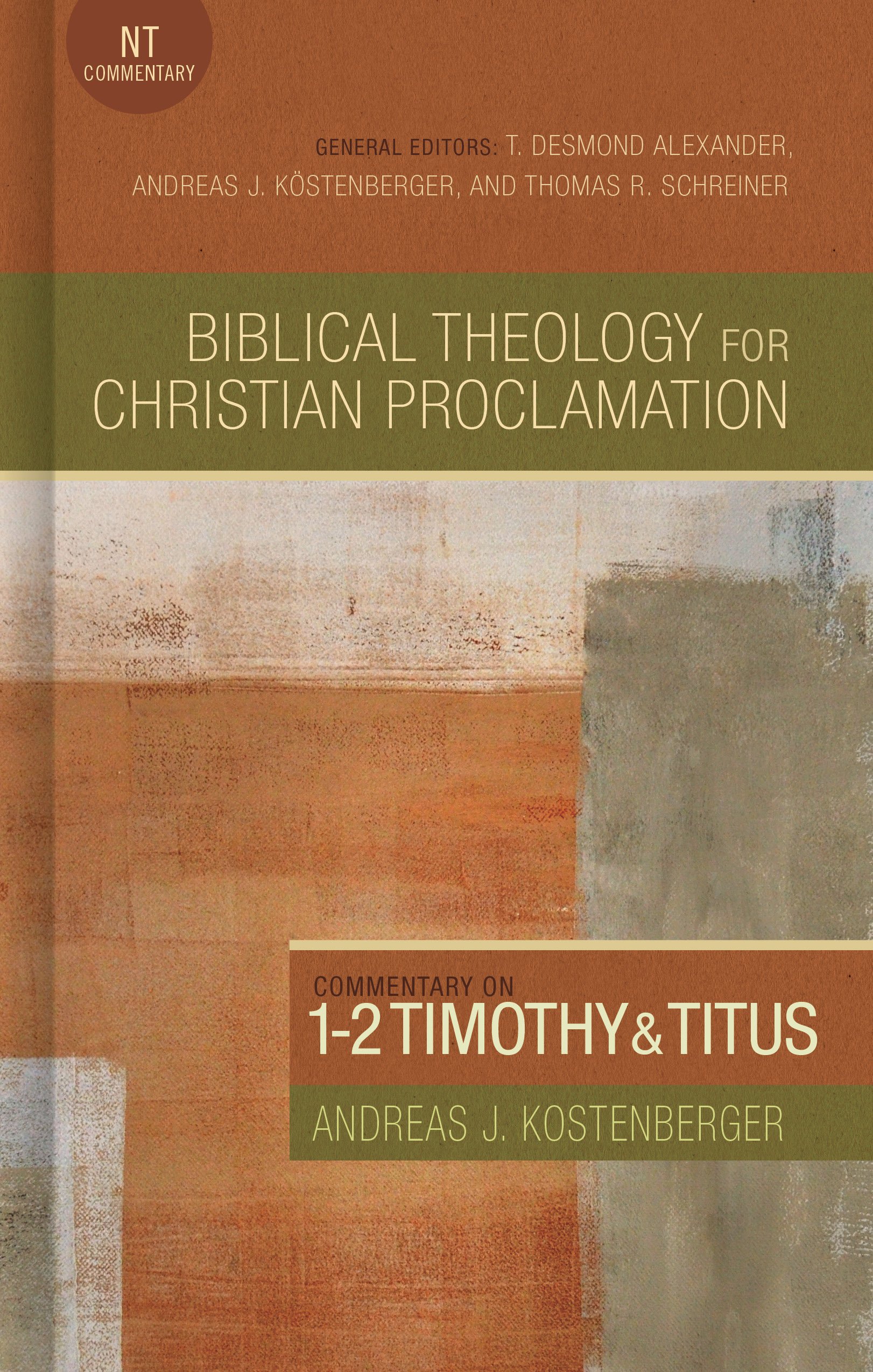We’ve been watching with interest to see the new Biblical Theology for Christian Proclamation series take shape. Andreas Köstenberger is one of the editors of this series of commentaries and author of the newest volume, Commentary on 1-2 Timothy and Titus. We have long appreciated his careful and faithful work, and so we took the occasion of the release of his new commentary to talk to him about it all.
Fred Zaspel:
First, tell us about Timothy and Titus and the “pastoral” epistles that bear their names. Who were Timothy and Titus? What was their relationship to the apostle Paul? And what kind of “pastoral” role did they occupy?
Andreas Köstenberger:
People quite commonly think of Timothy and Titus as resident pastors. However, most scholars now agree that “apostolic delegate” is a better way to describe their role. This is not merely another instance of splitting hairs and engaging in senseless semantic squabbles but rather accentuates the uniqueness of Timothy’s and Titus’s identity in relation to the apostle Paul within the framework of the apostolic era. Paul derived his authority directly from the risen Christ who appeared to him on the road to Damascus and commissioned him to take the gospel to the Gentiles. By his apostolic authority, then, Paul gathered around himself what is often called the “Pauline circle” consisting of coworkers some of whom he dispatched to trouble spots as needed. In Timothy’s case, the trouble spot was Ephesus, where he needed to “charge certain persons not to teach any different doctrine” (1 Tim 1:3). In Titus’s case, his assignment led him to the island of Crete, a place of grave immorality, where he was charged with “put[ting] what remained into order, and appoint[ing] elders in every town” (Titus 1:5). What this meant was that Timothy’s and Titus’s role was only temporary, not permanent. They came alongside existing leadership—or in Titus’s case, appointed it—and once their mission was accomplished, were dispatched by Paul to a new location (in Titus’s case, Dalmatia, modern-day Albania or Croatia; 2 Tim 4:10). That said, it is of course true that while they were in a given location, Timothy and Titus fulfilled many pastoral duties such as preaching, teaching, and various other kinds of service.
Zaspel:
What do these epistles reveal about Paul’s larger mission strategy and work?
Köstenberger:
In my commentary, I spent considerable time exploring the mission motif as an often neglected yet absolutely vital and foundational biblical-theological theme in Paul’s letters to Timothy and Titus. I believe when comparing, say, Paul’s ministry in Athens per Acts 17 and his missions strategy in his letter to Titus, several points of contact emerge. Paul was a keen student of culture and masterfully contextualized the gospel in a given environment. Also, we see that he targeted urban centers and gave significant attention to appointing leaders who had the heart and the character to shepherd God’s people. As N. T. Wright astutely observes in a little-known but seminal essay which I discuss at some length in my book, Paul considered himself as a “herald” (kēryx, 1 Tim 2:7; 2 Tim 1:11, translated “preacher” in the ESV). That is, as was customary in the first-century Greco-Roman world, Paul conceived of his task as making initial proclamation of the gospel in a given region after which he would move on to do the same in the next location. Thus, he was in need of apostolic delegates such as Timothy or Titus whom he could dispatch to consolidate the congregations he had established and to ensure proper leadership. Those are just a few nuggets I found in my research; if you want more, you’ll just have to buy the commentary!
Zaspel:
Okay, let’s talk about the commentary itself. Tell us about Biblical Theology for Christian Proclamation series of commentaries. How do they hope to be distinctive? What contribution do they attempt to make?
Köstenberger:
This is a massive new series with a projected 40 volumes spanning both Testaments and a stellar lineup of contributors. So far only the inaugural volume by Tom Schreiner (on Hebrews) has been published. My commentary on 1-2 Timothy and Titus is the second volume in the series, with another 38 volumes remaining! The general editors of the series are T. D. Alexander, a well-known OT scholar teaching in Northern Ireland, Tom Schreiner, and myself; associate editors are Jim Hamilton, Ken Matthews, and Terry Wilder. The publisher, B&H Academic, is to be commended for their vision and sustained commitment to bringing sound biblical theology to the pulpit. Every volume consists of an introduction covering the conventional historical background, matters of date and authorship, and so on; a succinct yet meaty standard commentary; and, as the main distinctive of the series, a substantial treatment of the major theological themes in a given book or corpus, called “biblical-theological exposition.” In my case, there a little over 50 pages of introduction; 300 pages of commentary; and almost 200 pages of biblical-theological exposition. As Craig Keener says in his endorsement, “I know no other major attempt to catalogue the theology of the Pastoral Epistles in this way.”
Zaspel:
Of course we expect to hear much from these epistles about the church, the function and responsibilities of its leadership, and so on. Having worked through these letters so carefully were there any pastoral or church-related themes that stand out in your mind? And did you notice any significant contrasts between Paul’s instructions with regard to these churches and the way churches typically function today—whether due to that historical situation or otherwise?
Köstenberger:
The theme that impressed me the most was the depiction of the church as God’s household. There are several reasons for this. First, there is a very significant ramification of this depiction for the debate on men’s and women’s roles in the church. Both first-century Jewish and Greco-Roman households were patriarchal, which renders the argument that Paul, rightly interpreted, espoused egalitarianism, as evangelical feminists suggest, highly implausible, not merely on exegetical and theological grounds but also as a matter of ancient background and culture.
Second, the household model provides a very important and attractive alternative and complementary model to the depiction of the church as the body of Christ. While the “body of Christ” metaphor focuses on the church’s close relationship with Christ (the head) as his body, and stresses the variety of gifts the different members of the body are to exercise for the common good, the household metaphor captures the important truth that the church is the spiritual family of God. In Christ, we are all brothers and sisters. What is more, this characterization has very significant implications also for the way in which we conceive of the role of pastoral leadership. Similar to the head of a patriarchal household, church leaders are to serve the various members of the household and help meet their spiritual needs in a variety of ways, whether older or younger people, male or female, children, widows, single people, and so forth.
Thus, a pastor who does not deeply care for the needs of the people in his church has entirely missed his calling, no matter how well he preaches or how good he may be at administering the church. I find that this model of the church as God’s household has great potential for revitalizing a church that is often a dry place where people have a hard time connecting. It holds forth a vision of a community led by pastors and elders who deeply care for the diverse needs of every individual.
Zaspel:
The Pastoral Epistles are not often recognized for their contribution to the New Testament teaching on salvation. But from the looks of your work you would like to correct that misperception, right?
Köstenberger:
Well, yes, I would. When I first started working on this commentary, I spent several weeks simply reading through the letters to Timothy and Titus multiple times, taking notes, noting repetitions and emphases and distinctive phrases and ways of looking at things. Through this inductive process, I surfaced a list of themes that I subsequently organized in the form of several major themes with several constitutive subthemes. I also asked myself the question which theme or themes seem primary are which themes are of a more supportive nature. Then, I read everything I could find that others have written on the theology of the Pastoral Epistles to correct any misperceptions on my part and to benefit from the learning and scholarship of others before me. What I found was that salvation emerged as a preeminent theme in the Pastorals, and, if anything, God and Christ seem to serve in conjunction with the provision of salvation. This is particularly the case with the phrase, found in the NT only in the Pastorals, “God our Savior” or “Christ our Savior,” as well as other salvation language. I realized that it only makes sense that from a human standpoint salvation is of first importance, as we are all sinners in dire need of salvation, and—praise God—God, in Christ, provided salvation. By comparison, the Holy Spirit is mentioned only rarely. In conjunction with salvation, as one might expect, the mission theme is very prominent in the letters to Timothy and Titus, as is the theme of sound (i.e., healthy and life-giving) teaching. Again, you’ll have to take a look at the 200 or so pages in my commentary to get the full picture.
Zaspel:
How would you characterize the overall teaching or theme(s) of the Pastoral Epistles and their value to the church today?
Köstenberger:
In my view—and I think this is not only because I wrote my commentary on these letters—the letters to Timothy and Titus are among the most important writings in all of Scripture as far as their value for the church is concerned. That said, we need to make sure we read these letters in a biblical-theological vein, that is, with careful attention to their historical grounding and the theology as it emerges inductively from these letters themselves. This is where we learn about the important of mission and the gospel; about the unique salvation God provides in Christ; about the way in which church leaders must stand firm against false teachers who are harbingers of the last days in which Satan attempts to infiltrate the church and to cause it to lose sight of its foundational truths and its mission. This, as mentioned, is where we learn that the church is “the household of God, which is the church of the living God, a pillar and buttress of the truth” (1 Tim 3:15). It is my hope that through this commentary I can make a small contribution toward reviving Paul’s vision for the church in our day.
Editor’s Note:
Köstenberger is also the editor of the Biblical Theology of the New Testament series. Be sure to watch for our upcoming interview!

